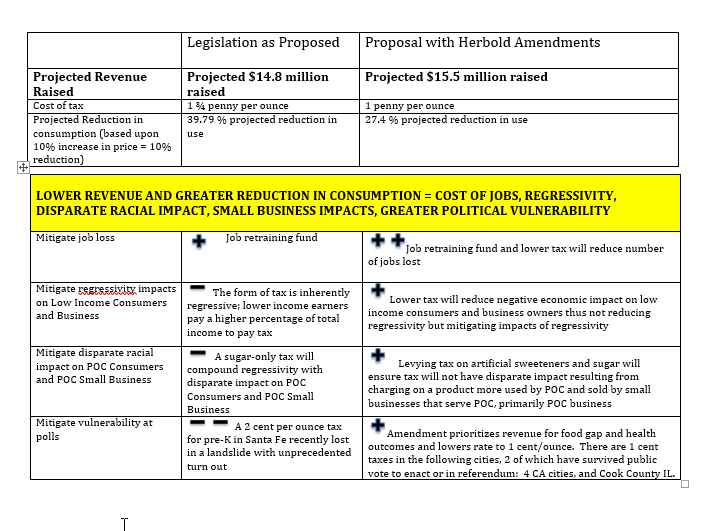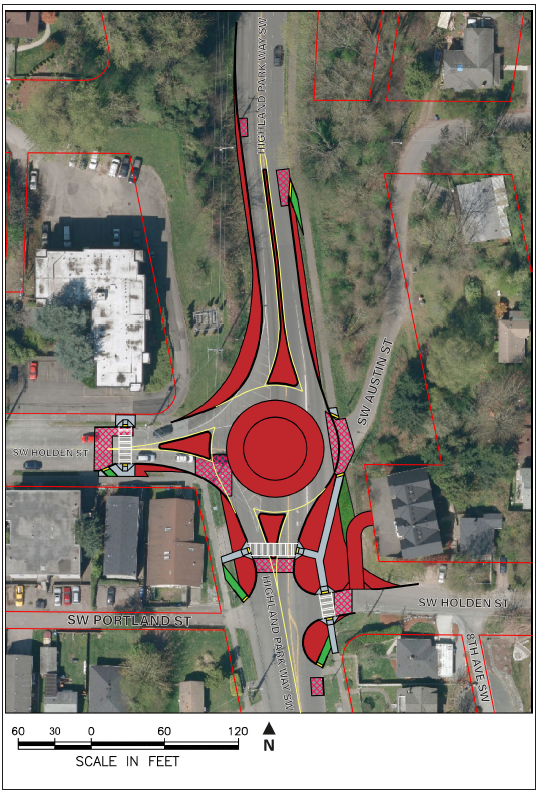Sweetened Drink Tax; South Park Pride Picnic; Highland Park Find It Fix It Walk & Roundabout Design Funding
Yesterday, in the Affordable Housing, Neighborhoods and Finance Committee the public finally saw the newly proposed bill for the sweetened drink tax. This has been an issue that I’ve been tracking closely for the last couple of months as I’ve had several concerns about not only how to spend projected revenue, but about the tax itself.
I voted no on the final package yesterday. The bill will be heard and voted on at Full Council this coming Monday, June 5th. The tax, if passed and enacted, will support a lot of good programs like addressing the food gap with Fresh Bucks (Fresh Bucks provides a dollar-for-dollar match on EBT (SNAP/Basic Food/Food Stamps) purchases (up to $10 per day) at participating farmers markets to spend on fresh fruits and vegetables), and funding Pre-K and Seattle College’s 13th Year. I support those programs so I’m writing to let you to know why I voted in opposition to the tax that is proposed to fund them.
This kind of tax will always be a regressive tax, meaning that the tax burden of this kind of tax will always be greatest on those with lower incomes. Despite my concern about our reliance on regressive taxes, and the fact that the Council is currently discussing passage of an income tax so that we can get out from under our regressive tax structure, I was still willing to consider supporting this tax. Unfortunately, the bill that came out of committee isn’t only regressive, I feel that it is punitive to low income people and small businesses. See here for why I feel this tax goes beyond acting as a deterrent like the taxes we levy on cigarettes, alcohol, and cannabis, but is actually punitive to consumers:
In addition, the tax as proposed in committee, has a racially disparate impact on people of color. The Mayor and Council’s Racial Equity Toolkit (RET) analysis of the tax proposed only on sugary drinks and not diet drinks concluded that, “In contrast to these trends for sugary drinks, Whites and high-income Americans are more likely to drink diet soda compared to communities of color and low-income Americans.” Consequently, in response to the RET findings, the Mayor wisely amended his proposal to include artificial sweeteners, in their report they wrote that: “including drinks with artificial sweeteners and lowering the overall tax, the impact will be spread across a broader cross-section of Seattle residents and will have smaller impact on low-income communities as businesses will not have to raise prices to the same extent.”
Due to my concerns with the proposal that was distributed to Councilmembers at 5pm on the Tuesday before the Wednesday meeting, my staff and I worked through the night to bring three amendments to committee on Wednesday morning:
- A reduction in the tax rate from 1 ¾ penny per fluid ounce to a more fiscally responsible and measured penny per fluid ounce.
- Prioritization of funding to programs that close the food security gap, as well as access to healthy food programs such as Fresh Bucks – over that of programs to support early childhood learning.
- Expansion of the definition of “sweetened beverage” to include taxation on beverages sweetened with non-caloric sweeteners (“diet” beverages), excluding zero-calorie natural sweeteners (e.g. Stevia).
Unfortunately, the amendments to significantly reduce the tax rate and include diet beverages failed at committee, but my amendment to prioritize nutrition and access to healthy food programs passed unanimously. Councilmembers have argued for a higher per ounce tax because they feel that a higher tax will result in more consumers reducing their use of these products. Healthy Food America says that a 10% tax results in a 10% reduction in use. If that is true, my proposal still would have resulted in a nearly 27% reduction in use. I have concerns basing our policy decisions on this 10% reduction formula because it is not clear that the data considers that jurisdictions with this tax, some people cross the jurisdictional boundary (like across Roxbury to the Safeway) to buy their soda.
Since the committee vote, I have learned that the City Budget Office (CBO) projects that a 1 cent per ounce tax that includes diet would raise $15.5 million in annual revenue. Alternatively, the package that was passed out of committee yesterday is projected to raise only $14.8 million a year with a 1.75 cent per ounce tax that does not include diet.
 I hope my colleagues on the Council will see, now that these new revenue projections are out, that my proposal not only raises additional revenue – more than the revenue raised by the version that moved out of committee – for important programs that we all support, but also reduces the negative impacts of this regressive tax on low income people, jobs, and small business, and in doing so creates a more responsible package that balances several important competing policy considerations.
I hope my colleagues on the Council will see, now that these new revenue projections are out, that my proposal not only raises additional revenue – more than the revenue raised by the version that moved out of committee – for important programs that we all support, but also reduces the negative impacts of this regressive tax on low income people, jobs, and small business, and in doing so creates a more responsible package that balances several important competing policy considerations.
The 7th Annual South Park LGBTQ Pride Picnic is coming up this weekend. There will again be free tamales for the first 200 people to arrive, prepared by Carniceria el Paisano in White Center!
There will be several local performers including Carlos Cascante and his band Tumbao, EmCee Isabella of Noche Latina, Aunt Betty Malone of Rainbow Bingo, and the Sisters of the Motherhouse of Washington.
When: Sunday, June 4, 2017.
Time: 1 – 4 p.m.
Where: Duwamish Waterway Park 7900 10th Avenue S
Check out the Facebook event and RSVP here.
Highland Park Find It Fix It Walk & Roundabout Design Funding
Last Thursday, May 25, I participated in the Find It, Fix It community walk in the Highland Park neighborhood in West Seattle. Here’s a map of the walking route, which was focused on SW Holden between 9th and 16th.
Find It Fix It walks provide an opportunity for community members to identify neighborhood needs and discuss challenges directly with City leaders.
The first stop was at Riverview Playfield. Paul West noted the Parks Department will be rebuilding the restroom this summer that was damaged in an arson, and also talked about the need to replace the telephone poles adjacent to the park, which prevent cars from driving on and damaging fields. He also talked about trails in the West Duwamish Greenbelt, and noted their Facebook page, with a website coming soon.
The second stop focused on speeding through residential streets between 9th Avenue SW and 16th Avenue SW. Alan Robertson noted that Highland Park Way is one of only three east/west access points to the peninsula (if you could the upper and lower West Seattle Bridge as one access point). As a result, lots of traffic comes through the neighborhood from and to other neighborhoods in West Seattle. Backups on SW Holden often result in motorists driving on side streets at high speeds.
SDOT’s Jim Curtin noted that the speed limit on non-arterial streets have been reduced from 25 to 20 mph, which allows SDOT to deploy traffic calming measures in a more streamlined fashion, and allows SPD to do more vigorous enforcement. He also noted that a 2016 Neighborhood Park and Street fund project for a traffic circle at 12th and Kenyon is moving forward, and currently in design. He further noted that in 2017, a raised crosswalk will be added at SW Myrtle Street, a curb bulb and flashing beacons @ Kenyon Street; SDOT is looking at flashing beacon @ SW Webster Street. He also noted a project under consideration in the Neighborhood Street Fund “Your Voice Your Choice” process is for crossing improvements at SW Henderson and 11st SW, near Highland Park Elementary. SDOT also noted the presence of the crosswalk with curb bulbs and flashing beacons at 11th and SW Holden was a community-generated project.
The walk then went to talk about the intersection at Highland Park Way SW and SW Holden. The community has long advocated for a solution for pedestrian and motorist safety at this intersection, which has seen numerous recent accidents; Michele Witzki noted the community has requested action at the intersection dating back to 1941. During last year’s Neighborhood Street Fund process the community proposed a traffic roundabout (as they had in 2013), and SDOT did a conceptual design. It was the highest-rated project of the Delridge District Council, but wasn’t selected in the final city approvals, in part due to the cost.
I’ve worked with the Mayor on locating funding for initial design work, and announced that SDOT will be dedicating $200,000 of existing funds to advance design for a roundabout, to improve safety and alleviate congestion by improving traffic flow, which could also help lower the incidence of drivers using side streets. Thanks to Mayor Murray and SDOT for agreeing to do this work, which should make it easier to apply for grants. Earlier that day, SDOT met with representatives of the state Transportation Improvement Board on-site about applying for a construction grant, and they were bullish on the project according to SDOT.
The other item discussed at that location was about the February landslide, which closed Highland Park Way for a few days.
I did some research during the first quarter supplemental budget process, and found that in 2000, SDOT performed a risk assessment for slope hazards for landslides on arterial streets in Seattle. The assessment rated 24 locations as high priority; however, only 7 have had proactive mitigation work done, since a majority of the approximately $500,000 allocated annually since then has been used for reactive work in other locations.
I’ve been working with the City Budget Office to advance funding to accelerate this work. Here’s a link to a letter I distributed during the committee discussion.
For Highland Park Way, SDOT says they are periodically monitoring the site and has asked for a small amount of additional funding for this site ($60K, lumped in with the other landslide mitigation requests) in the 2018 budget to install a rock buttress and ecology block wall in the right-of-way. I will try to get that funding this year instead in the second quarter supplemental budget legislation.
The next stop was at the staircase on the north side of the street at SW Holden and 14th Avenue SW, with a review of the condition of the staircase, and needed maintenance. The final stop was at the surplus City Light property on the southwest corner of 16th Avenue SW and SW Holden Street. Business owner Jenni Watkins and resident Beth Adrisevic talked about the intersection, and the property. The lack of a left turn signal was noted, an issue which also affects traffic onto side streets.
In late 2015, the community requested that City Light not immediately sell the property, to allow the community time to pursue a rezone to allow for a mixed-use housing development with an opportunity for low-income housing and/or commercial uses, which the community lacks. Then Councilmember Tom Rasmussen removed this location from legislation placing the property for sale. Last year I asked OPCD Director Sam Aseffa to include this property in the MHA rezones, and he agreed. That process is ongoing.
Here’s a link to the Seattle Channel’s video of the walk.
Posted: June 1st, 2017 under Councilmember Herbold, Economic Development, LGBTQ, Parks and Recreation, Police Department, Public Health, Seattle Public Utliities, Transportation
Tags: Highland Park, LGBTQ, South Park, tax



